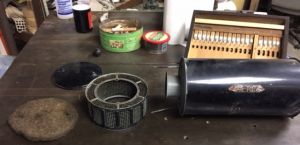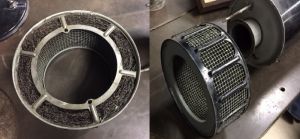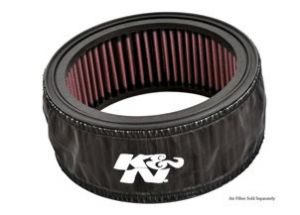- Home
- About Us
- Join/Renew
- Member Benefits
- Member Pages
- Log In
- Help
- Museum Store
Has anyone installed a K&N air filter in a ’36 eight?
If so, would you provide the applicable part number(s) used.
K&N’s “search by make,” while thorough, only goes back to 1941.
Thank you, Stu Blair
I looked up the throat OD of the carb on my ’29 and browsed through their catalogue until I found one that fit the OD of the carb.
It took awhile but it was the only way to get one that I was sure was going to fit.
I eventually found a uni-pod style filter.
Hi Stu,
Interesting question about better filtration. I went out and took apart the one on the ’36 eight that is in the shop. After pulling everything apart I can see why K&N would not list such a filter.
Once you take the filter area apart you will see it looks like a Brillo pad that has been stuffed into a metal cage. If you were to cut each of the thin metal tabs, you could, maybe, stuff a filter into the unit.
After looking at the overall dimension of the metal cage, the filter would need to be a little shy of 7 inch’s in diameter and about 3 inch’s deep. I could not find anything that would fit this size….unless you want to cut down a filter.

After looking closely at the metal cage/unit, it might not be a good idea to cut the tabs as that is the way the are held onto the unit.
You can see in the picture that the two nuts thread through onto the studs.

I feel the best way to give you filter better filtration is to use a K&N Drycharger Filter Wrap. This is like a “bag” that goes over the outside of the filter area to provide more filtration. It would also ensure the integrity of the cage. You could clean the metal filter with cleaner then install this wrap on the outside of the unit to provide better filtration.
Here is a quick description of the Drycharger Filter Wrap:
“The filter’s location may expose it to unusually high levels of dust, tire spray, or even splashes of water. One way to help shield the filter from these elements is to use a DryCharger filter wrap.”
Wrap Type Drycharger
Color Black
Material Used Silicone Treated Polyester
Inside Diameter 7 in (178 mm)
Height 2.25 in (57 mm)
Closed Top No
The link below should be the correct dimensions for covering the outside of the metal air cleaner on your 1936 eight.

I would use the K&N for everyday driving and use the stock filter for display and show purposes.
Here is one that doesn’t work, a trial fitup. I installed one of these on my Packard, it is removable and replaceable with the original but is too long on my 845 Eight Pierce, the fan blade would hit it. Perhaps it could be used on other P-A models. It is Purolator A24630 and was great because it has a pretty large flow area. Back to the drawing board on the Pierce 8.
Looking at the K&N site they have one universal filter that might be adaptable for driving use by cutting the rubber universal clamp flange off and using the original Pierce end cap and screws to hold it on. It could then be swapped with the original for show by removing the two end nuts. It would stick out from the body .25″. It is K&N number RU-1850, 7.50″ OD, 6.0″ ID, 4.5″ long.
The wrap mentioned above looks like it is just to keep the big chunks out which is all the original P-A mesh filter does. It is mainly to extend the life of a finer filter under it. Neither is going to keep the fine sand particles out that are the biggest cause of wear to the ring and bore – particularly if the engine only has basic cast iron top compression rings. Engines were commonly re-rung at 15000 miles back then.
When the paper pleated air filters were introduced they were perhaps the biggest improvement to reduce ring and cylinder wear together with chrome rings. They are more effective at filtration than the oil baths that became popular in the 1930’s, but I think the main reason they weren’t adopted earlier was cars were still being driven on dirt roads and a fine mesh filter would plug too quickly. The oil bath doesn’t filter as well but can tolerate a lot more dirt.
Perhaps not authentic, but a pleated air filter will keep more of the original authentic metal in the cylinder when driven. I hate digging out the fine metal particles from the magnetic plug when I change oil.
Jim
I have used a K & N Filter inside the original Pierce filter housing on our 1936 1601 since it’s rebuild 15 years ago. Simply matched the dimensions to a K & N listing.
Dave Stevens
K&N part number E-3380 is perfect for Pierce-Arrow 8s 1933-38. Remove the cage with the brass mesh, put it in the K&N box and on your shelf. This p/n MAY wok on Pierce 12s as well, check your dimensions.
My 1930 (updraft) came to me with a filter consisting of outer can with a cylinder of hardware cloth holding in fine-mesh brass screen–which keeps out boulders and large insects. I added K&N filter wrap material inside the brass screen (about 15′ linear if I recall) but also an inner cylinder of hardware cloth to keep the carburetor from sucking the filter wrap inwards. All you see is the outer hardware cloth (painted flat black) and the natural-color brass screen, about two layers. Note that the filter WRAP must have K&N oil added; the oil does not come with the filter wrap product.
Make that 15 linear INCHES of wrap material.
Thank you all for your replies; a K&N filter has been ordered.
Best regards, Stu
A quick note regarding the Pierce 8 air filter. The factory, as well as the K&N replacement element is held in place by an end-cap on the filter assembly. There are two studs or captive bolts sticking out of the front of the filter assembly, the filter element fits over the two studs, then the end cap has two holes matching the studs. There are two washers and two wing-nuts holding the end cap against the filter element.
The reason for the long and if you have a ’33 and later Pierce 8 obvious description is to HIGHLY suggest that a hole is drilled in the ‘wing’ of each nut. Then safely-wire the two wing-nuts together. This is to prevent the engine vibration and heat cycles from loosening the wing nuts..
On George Teebay’s ’34 Silver Arrow when we were returning from the Minden meet developed an odd rattle from under the hood. I looked several times but i could not get it to ‘rattle’ when i was watching and listening with the hood open.. Finally on a fuel stop, it was rattling pretty consistently, i opened the hood and discovered the two wing-nuts were about one turn from falling off the studs. The next item to fall off would have been the end-cap, and it would have fallen directly into the fan, and shredded the radiator, the filter, upper radiator hose and who knows what else..
There were lock washers under the wing-nuts. but the wing-nuts could not be tightened enough to make the lock washers effective without crushing the filter element. Safety wire will always keep the wing-nuts from backing off the studs.
Greg Long
Further to Greg;s post immediately above: The OEM metal cage was secured by acorn nuts, not wing nuts, which could be made more effective by using lock washers, or even star washers. under the acorn nuts. But because the cage is replaced by the rubber perimeter of the K&N filter, applying enough pressure to secure lock washers would crush the rubber perimeter of the K&N filter.
Accordingly, to get the benefit of the improved filtration of K&N over factory oiled copper mesh, it’s necessary to secure the filter element in place by the method Greg described.
Greg / George,
FYI, the K & N E-3380 was received; the outer plastic perimeter flange was trimmed-off with an Exacto knife and the filter actually fits inside the metal cage with the wire mesh removed. The whole assembly went back together as it came apart without any special lock washers, etc. and it’s back in the car.
Thank you both again, Stu
Stu, glad it’s working for you, and thanks for sharing that method of hiding the K&N.
